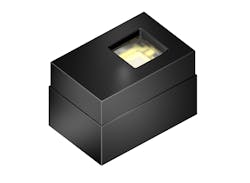Always adding to its considerable belt of photonics chips, Osram has now developed an infrared laser diode that it says will help smartphone cameras take pictures focusing the foreground while blurring the background.
The newest member of its Bidos line of vertical cavity surface-emitting lasers (VCSELs) uses time-of-flight (ToF) principles, in which a processor measures how long it takes for light beams from the same source to make a round trip to different objects and back.
ToF is also a technology used in lidar (light detection and ranging) to guide autonomous cars. In the case of Osram’s new camera-oriented Bidos PLPVDC 940_P_L01, light will travel back faster from the face of a person in the foreground than it will from, say, trees or buildings further away. The processor then knows to blur the pixels associated with the background.
Osram claims that such an effect typically requires high-priced professional cameras or lenses. It did not say how much it is charging for the new VCSEL, which can also be used for other functions on phones, such as 3-D object recognition and augmented reality applications including games and interior design.
VCSELs are generally pricier than LEDs. Osram opted for VCSEL technology in this case because the coherent, in-phase nature of laser light is suited for the focused, directional task of ToF. LED light, even light tuned to emphasize a particular frequency, does not have the same coherency, and it emits light in a more scattered and lambertian manner than the direct emission of lasers.
The Bidos PLPVDC 940_P_L01 emits 940-nm light, a frequency also emitted by two infrared LEDs (Osram calls them IREDs) that Osram introduced over the last year — the Oslon Piccolo for gesture control in car navigation systems, and another Oslon chip positioned for facial-recognition-based security systems in smartwatches.
Both of those LEDs are also available in 850-nm versions which are more powerful than the 940-nm device. The Piccolo’s 850-nm version is more powerful than the 940, but it emits what can be an annoying red glow not detectable at 940 nm.
The new Bidos VCSEL is rated at 3W and packaged with a 3.6×5.46-mm footprint including the photodiode, optics, and an intelligent microcontroller for driving the VCSEL. It has an effective ToF range of up to 7m, Osram said.
Osram has for several years been emphasizing its photonics over general illumination. In the process it has introduced a steady stream of LED and VCSEL chips with specific applications in mind.
Those chips have often included infrared. In addition to the Oslon products for car navigation systems and smartwatches, in February 2018, the company introduced two infrared chips in its Synios line aimed at facial recognition to unlock phones and tablets, using 940 nm to eliminate glow of the earlier 850-nm Synios model. Later that year, an infrared chip in its Synios line was aimed at helping consumers use phones to detect the contents of food. Also in 2018, it introduced a near-infrared Oslon Black chip to help farmers detect when crops are ready to harvest.
In June 2017, Osram introduced the small-footprint SFH 4055 LED that emits at 850 nm for use in augmented and virtual reality (AR and VR) applications.
Along the way, it has also added laser chips to the mix. In late 2018, for example, at around the same time of introducing even more facial recognition IREDs, it also introduced VCSELs (vertical cavity surface-emitting lasers) to provide three-dimensional facial recognition, a step up from the two dimensions of LEDs. That introduction came only a few months after Osram added other VCSELs for facial recognition.
The panoply of photonics chips comprises a wide array of lines including Oslon, Synios, Duris, OsconIQ, SolerIQ, ChipLED, Displix, and others.
Within those lines, Osram typically subdivides the offerings into high power, midrange power and low power.
Some of Osram’s offerings would seem to overlap with those of ams, the Austrian smartphone-oriented sensor company that has acquired Osram pending regulatory approval. It’s not yet generally known how the two companies will sort out similar product offerings. The nature of their acquisition agreement has undermined their ability to discuss organizational integration; meanwhile, ams is also still trying to figure out how to finance the deal.
MARK HALPER is a contributing editor for LEDs Magazine, and an energy, technology, and business journalist ([email protected]).
For up-to-the-minute LED and SSL updates, why not follow us on Twitter? You’ll find curated content and commentary, as well as information on industry events, webcasts, and surveys on our LinkedIn Company Page and our Facebook page.






